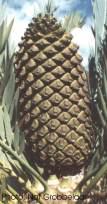Encephalartos lehmannii
Encephalartos lehmannii Lehm.
Family: Zamiaceae
Common names: Karoo cycad
SA Tree No: 8.1
Introduction
This cycad has been described as the hardiest, most drought resistant of the South African species. In the past, many specimens of this cycad were removed from the wild for cultivation.

This cycad has been described as the hardiest, most drought resistant of the South African species. In the past, many specimens of this cycad were removed from the wild for cultivation.
Description
Description
This low-growing, small to medium cycad with an erect trunk up to 2 m tall and 400 mm across, forms clumps of up to 10 stems, with suckers produced from the base. Old leaf bases form ring patterns on the stem, the surface of which is papery and dry. It has beautiful blue leaves which are 1-1.5 m long. The whorls of leaves become entangled as the plant becomes bushy and the crowns appear to lose individual identity.

Male and female plants produce a single cone per stem. Male cones are sub-cylindrical, 250-350 mm long, 80-100 mm in diameter, carried on a short stem (peduncle), 50-120 mm long. They are bluish green, with a covering of blackish red, fine hairs which thin out as the cone grows, allowing the green to show through.

Female cones are barrel-shaped, 450-500 mm long and approx. 250 mm in diameter. They are similar in colour to male cones, if slightly darker. They also have distinct, slightly 'warty' ridges separating otherwise smooth facets of cone-scales and a covering of fine, brownish 'hair'. Seeds are deep red in colour.
Coning occurs every two years if sufficient rain falls, but may cease during prolonged droughts. Seeds are capable of germinating even if only occasional light mists occur to provide moisture.
Distribution and habitat
Distribution description
This plant is endemic to the interior of Eastern Cape in South Africa where it grows in the catchments of several rivers. Its habitat is semi-arid with an annual rainfall around 250 - 350 mm. Rain falls mainly in summer, but rainfall is very erratic and this cycad can survive prolonged droughts. It is found mostly on sandstone hills, mountain slopes, but occasional clusters can be found on hard, open ground at the edge of dry watercourses. This region is very hot in summer and cold in winter with frequent frosts. Plants grow in full sun and are often surrounded by thorn scrub species of aloe and euphorbia. The surrounding vegetation is not as prone to fire as some grasslands.
Derivation of name and historical aspects
History
This cycad is named in honour of Professor J.G.C. Lehmann, a nineteenth century German botanist who described several cycad species in 1834 and established the genus Encephalartos.
Growing Encephalartos lehmannii
Grow
This cycad is easy to cultivate. It is an extremely hardy and attractive species with excellent ornamental qualities. It requires neutral to alkaline soil with very good drainage. If grown in shade and with too much moisture, the leaves will lose their metallic blue colour and will turn green, so plant it in a sunny position. It is suited to temperate regions including those with a semi-arid climate and tolerates moderate to heavy frosts. Do not over-water.
Propagation: From seed and by removal of suckers which transplant readily.
Pests: to be on the lookout for in southern Africa: Leaf parasites range from moth larvae to plant lice and can all be rather well controlled with contact insecticides. Cone parasites, mostly beetles or weevils, attack the cones of both male and female plants and can cause great destruction. Spray the cones with insecticide just before the cones become sexually mature and for some weeks after. Be very careful before spraying: make sure the beetles on the plants are actual pests and not pollinators.
Stem/trunk and root parasites: larvae from certain beetles have been known to infiltrate the trunks of cycads causing rot to set in, which if untreated, can kill the cycad. Treat with a systemic insecticide and in addition, carefully cut out any infected trunk tissue, then sterilize and seal the trunk to stop any fungal and bacterial infection.
Certain ant and termite species are known to attack the roots and the underground part of the trunk, causing damage and leaving the plant vulnerable to fungal and bacterial infections. Various insecticides are available on the market to combat these problem insects.
Various fungicides are available to fight fungal infections. Infected and even old dry leaves should be removed and burned to stop any remaining spores from germinating. Bacterial infections are a more difficult matter and up to date, nothing on the market has proved to be really effective.
For information on pests in the rest of the world, please contact your nearest nursery or cycad expert.
References
- GIDDY, C. 1974. Cycads of South Africa. Purnell, Cape Town.
- GOODE, D. 1986. Cycads of Africa. Struik, Cape Town.
- GOODE, D. 2001. Cycads of Africa, vol. 1. D & E Cycads of Africa, Gallomanor.
- GROBBELAAR, N. 2002. Broodbome. Met spesiale verwysing na die Suider-Afrikaanse soorte. Pretoria.
- HILTON-TAYLOR, C. 1996. Red Data List of southern African plants. Strelitzia 4. National Botanical Institute, Pretoria.
- JONES, D.L. 1993. Cycads of the World: ancient plants in today's landscape. Reed, New South Wales.
- KREMPIN, J. 1990. Palms and cycads around the World. Horwitz Grahame, Australia.
Credits
Lou-nita le Roux
Lowveld National Botanical Garden
April 2003
Plant Attributes:
Plant Type: Shrub, Tree
SA Distribution: Eastern Cape, Western Cape
Soil type:
Flowering season:
PH:
Flower colour:
Aspect: Full Sun
Gardening skill: Average
Special Features:
Horticultural zones











Rate this article
Article well written and informative
Rate this plant
Is this an interesting plant?
Login to add your Comment
Back to topNot registered yet? Click here to register.